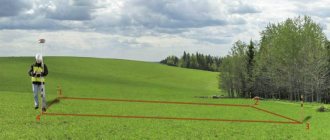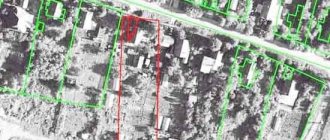Causes of boundary violations
A shift in boundaries occurs due to an error in the registry or an unauthorized change in boundaries. Reasons for violations of private property limits:
- The cadastral service specialist made a mistake during measurements and a shift occurred.
- Inadequacies in the Unified State Register of Real Estate documents led to a discrepancy between the boundaries of the site on paper and in reality.
- The documentation does not contain the territorial boundaries of the owners of the plot.
- The owners of neighboring plots arbitrarily violated the land survey plan.
Neighbors informally agree on a shift when they level areas, change the landscape, or build a joint pond. Subsequently, this leads to property disputes about the boundaries of land plots, where it is difficult to determine the culprit. Both owners may be subject to penalties.
Other people's lands are seized intentionally if they do not belong to anyone, are the economic territory of a gardening partnership, or go beyond its boundaries.
The summer resident moved the fence a couple of meters and increased his own area. The assigned territory is outside the partnership and is no one's territory. A harmless step will subsequently turn into a problem for all gardeners when municipal authorities want to expand the area of the partnership and provide land to the owners. The proceedings threaten the culprit with a fine for violating the boundaries of the land plot, and the new owners will not be able to draw up title documents without taking measurements and restoring the territorial boundaries.
Reasons for filing an application for neighbors
Each individual case of filing an application for residents of neighboring houses has many different nuances and special grounds.
The most frequently registered complaints are about the following actions:
- Frequent explosions of pyrotechnics, such as firecrackers, occurring near your property;
- Systematically occurring night festivities, showdowns, scandals;
- The land plot or the buildings built on it are used for other purposes, for example, a store is organized in a residential building;
- Neighbors are engaged in the illegal production and sale of alcoholic beverages;
- Citizens living on a neighboring property have damaged property that belongs to you, for example, a fence that surrounds the property;
- A neighbor takes waste into the local area or makes a mess around the house;
- The neighboring area is not properly maintained, for example, the area is not mowed or other necessary actions are not taken.
Responsibility and fines for trespassing
Anyone who appropriates someone else's property faces liability for an administrative offense. The fine is determined based on the cadastral value of the land and amounts to 1-1.5% of the amount. The amount of the penalty will be from 5 to 100 thousand rubles if the violator is an individual. A person will have to return someone else's land and demolish the buildings erected on the territory. The fine for a legal entity will be 2-3% of the cadastral value or 100-200 thousand rubles.
ATTENTION! The size of fines is constantly changing; in the regions, tariffs are set by executive authorities.
Where to complain about neighbors on a plot of land
You can send a complaint against citizens living in the neighborhood to several authorities.
Most often, applications are sent to:
- To the district police officer. Applications written according to the above sample are most often considered by an inspector, whose duties include taking measures to promote order in the territory entrusted to him. In this case, the most important thing is to fill out the application correctly;
- Police. A complaint filed with this body is one of the most effective ways to reason with offenders - few people want to deal with this body, whose methods are harsh. When neighbors are having noisy night parties, calling the police has a sobering effect, and systematic visits from employees of this body, who issue one fine after another, will for a long time discourage any desire to disturb the peace of neighbors;
- Court. The mere mention of an application submitted to this body has an amazing impact. It is necessary to submit several complaints from other neighbors or create a collective one, attaching existing evidence to it, in order to increase the likelihood of winning the case. An administrative fine, especially a large one, will force neighbors to reconsider their behavior.
Was the Recording helpful? No 49 out of 68 readers found this post helpful.
What to do if a neighbor violates boundaries
If a violation of the boundaries of the land plot occurs when a neighbor installs a fence, he is asked to return everything back and disperse peacefully. When the land owners have made changes by mutual agreement, they contact the cadastral service and invite an engineer who draws up a report and takes measurements.
If there are errors in the land surveying plan, neighbors write a statement to the allotment registration department with a request to make amendments.
When a peaceful agreement cannot be reached, the victim goes to court. If the plaintiff’s rights are found to be infringed, the violator returns the land and, in accordance with Article 7.1 of the Code of Administrative Offences, pays a fine.
Pre-trial dispute settlement
If the neighbors agree to solve the problem, they clarify what boundaries are indicated in the documents, check the results of land surveying after the initial registration of the site, refer to the urban plan or ask engineers to establish boundaries based on the location of the sites over the past 15 years.
New borders are established, neighbors agree, and territorial changes are entered into the Unified State Register of Real Estate. To do this, land owners draw up an application and provide:
- copies of owners' passports;
- certificates or extracts establishing ownership rights;
- document where an error was made;
- plan with new land boundaries.
It takes up to 5 days to make changes.
A sample application to the cadastral service is available.
Going to court
When the seizure of property was malicious and the neighbor refuses to return the property, the victim applies to the arbitration court of the area where the land is located to restore his rights, pays a state fee (at least 400 rubles) and prepares:
- copy of passport;
- a copy of the statement of claim;
- confirmation of the right to the allotment;
- documents illustrating the area and boundaries of the site (if there is no boundary plan, one is made);
- information about the inspection that established the illegal transfer of borders;
- assessment of the damage caused based on a lawyer’s analysis;
- other evidence for investigation.
The owner, independently or with the help of a lawyer, conveys his point of view to the judge, indicates that the boundaries are erroneous, asks for permission to restore the previous ones and return to possession of the illegally lost land without interference from the defendant.
IMPORTANT! The case is initiated within five days. The judge decides how long it will take to consider the issue. He may appoint an independent land surveyor or invite witnesses.
If the defendant’s guilt is proven, he is obliged to return the plaintiff’s possession, demolish his own buildings and communications, cover legal costs and additional examination. If the fact of unauthorized seizure of territory is proven, the violator receives a fine and compensation for material damage.
The court decision is transferred to Rosreestr, and the characteristics of the territories in the Unified State Register are updated.
How to write a statement against a neighbor in the area
The application to an official working for the department of public security, that is, to a district police officer, must be drawn up according to an officially accepted template, or in a form that meets all the requirements for filling out these documents.
This paper is drawn up in writing, but it is possible to convey the information directly in a conversation with a representative of the authorities, with the condition that all transmitted information will be recorded verbatim by the district police officer and certified by the signature of the applicant. The law also provides for the registration of any such application, which is carried out directly by the district police officer himself or at the duty station. This procedure ensures that the request submitted by the citizen will be considered.
If the application is drawn up in your own hand, its presentation must be literate and clear, and also contain all important information. The addressee of this document is the local inspector or internal affairs bodies. In the latter case, the submitted application is sent for consideration to the head of the department, who forwards it to the district police officer.
It is unacceptable to include your own reasoning and guesses in the application; you need to indicate only those facts that you saw with your own eyes. If there are witnesses to the phenomena described, their personal details and contact information should be indicated.
Having described in writing all the observed events and outlined the problem that has arisen, you can give examples of measures of influence that, in your opinion, should be applied to a citizen who has committed an offense. But only those measures that are provided for by the laws of the Russian Federation will be applied to the violator of the order. After the written text, at the bottom of the sheet the applicant must sign and decipher it, as well as indicate the date the application was written.
In order for the request to be guaranteed to reach its destination and be considered by the appropriate official, it must be submitted to the authorized body by mail, by sending a registered letter, or in person, by going through the official registration procedure and receiving a receipt.
The procedure for conducting an inspection by land control
The basis for an inspection by land control authorities is a statement of squatting of land that does not belong to the violator.
The inspection order must contain the following information:
- offender, his place of residence;
- location of the land and its unique number according to the cadastre;
- who is authorized to carry out this inspection;
- purpose of the procedure. In these circumstances - state land supervision over the exploitation of land ownership by a specific person on the basis of an application received from a citizen;
- the objectives of the event are to comply with the norms of land law, regulations on the protection of land plots and land use;
- the subject of the procedure is the implementation of regulations for the exploitation of land holdings, enshrined in the norms of state and municipal legislation;
- deadlines for completing the inspection;
- designation of the legal basis of the event.
Notifying the person for whom the procedure is planned about the inspection
The chief state inspector for the use and protection of land or a person replacing him is obliged to notify the citizen in respect of whom the inspection will be carried out about the upcoming event. The notice and a copy of the order regarding the planned inspection are sent to the place of residence of the person concerned by registered mail with return receipt requested or by other possible means.
State land supervision consists of several stages, which are as follows:
- planning an event based on an application submitted by a citizen;
- issuing an order to verify compliance by persons with the requirements of land legislation;
- coordinating the unscheduled inspection with the prosecutor's office (if necessary);
- execution of the procedure, preparation of inspection results.
Illegal construction
Regardless of where the applicant plans to file a complaint about illegal construction, he must correctly draw up a document, indicating the following information:
- details of the parties;
- exact address of illegal construction;
- a detailed description of the situation: how the construction site was discovered, where the applicant applied to obtain information about the availability of permits, how the conflict situation developed, etc.;
- how the illegal construction of the property turned out: flooding of the territory, cracks along the facade of the building, destruction of the foundation, etc.;
- references to legislative acts that should be followed when considering an appeal;
- requirements on the essence of the issue: take measures against the violator, dismantle the building, report the decision within the time period provided for this.
Additional materials should be attached to the inventory document (expert opinions, photographs of a building under construction, flooding, cracks in the house, etc.).
An appeal may be submitted by one person or by several persons. If we are talking about a collective complaint, it must indicate the personal data of all applicants, each of whom must personally sign the document.
The legislative framework
To correctly file a complaint, you should be guided by the following legislative acts:
- Code of the Russian Federation on Administrative Offenses dated December 30, 2001. N 195-FZ (as amended on July 31, 2020).
- Civil Code of the Russian Federation N 51-FZ dated November 30, 1994. Part I, N 14-FZ dated January 26, 1996 part II.
- Land Code of the Russian Federation dated October 25, 2001. N 136-FZ (as amended on July 31, 2020).
- Federal Law “On the procedure for considering appeals from citizens of the Russian Federation” dated May 2, 2006. N 59-FZ (as amended on December 27, 2008).
- Federal Law “On Specially Protected Natural Areas” dated March 14, 1995 N 33-FZ (as amended on July 31, 2020).
House windows facing the neighbor's yard
There are no laws that prohibit opening windows into someone else's yard. But according to the norms between the building and
the border of someone else's territory must be a certain distance. Alternatively, when the windows of a building look onto someone else’s yard, you can require them to be blocked or a green fence made. In this case, you can not only close yourself from the neighbors’ eyes, but also improve your territory.
According to the rules, it is necessary to obtain written permission from the owners of neighboring territories in order to place your windows on their territory. In this case, they should also meet halfway and allow them to somehow cover their windows. This can be done by planting shrubs. Written permission can help resolve conflict.











